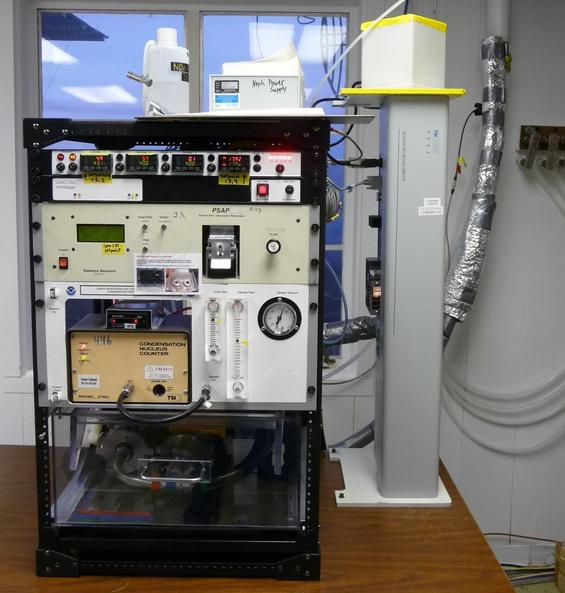The individual components for the basic system are described below, along with links to descriptions and pictures of each instrument. A description of an expanded system is provided here. The Aerosols group has also made measurements onboard light aircraft. Go here for information on the Aircraft Aerosol System
Basic Aerosol System
Click on a colored portion of the aerosol system map or on an instrument in the photo to see construction diagrams and images of the instruments and ancillary parts for ESRL's aerosol system.


Nephelometers
We use two types of nephelometers. The TSI nephelometer (TSI Model#3563) measures total scattering (between 7 and 170 degrees) and backscattering (between 90 and 170 degrees) by aerosol particles at three wavelengths: blue (450 nm), green (550 nm) and red (700 nm). The Radiance Research nephelometer (RR Model#903) is a smaller, lighter instrument. It measures total scattering at ~530 nm or ~545nm. Prior to ~2000 we also used MsE and MRI nephelometers.
Particle Soot/Absorption Photometer (PSAP)
The PSAP (Radiance Research) is a filter-based method that measures light absorption by particles at a single wavelength: green (565 nm) or three wavelengths (467, 530, 660 nm). Particles are collected on a filter and light transmission through the filter is monitored continuously.
Continuous Light Absorption Photometer (CLAP)
The CLAP is a NOAA/GMD developed, filter-based method that measures light absorption by particles at three wavelengths (467, 528, 652 nm). The CLAP is similar to the PSAP in that particles are collected on a filter and light transmission through the filter is monitored continuously. The CLAP differs from the PSAP in that instead of a single sample spot, it has 8 sample spots. Solonoids are used to switch to the next sample spot once the transmittance reaches 0.7. Thus, CLAP can run 8x as long as the PSAP before requiring a filter change, ideal for remote sites which aren't visited daily.
Condensation Nuclei Counter (CNC)
The aerosol systems in our collaborative network use various types of CNCs to measure particle number concentrations. Particles are drawn into the CNC and vapor is condensed on the particles so that they grow to a size detectable by the instrument optics and thus can be counted.
